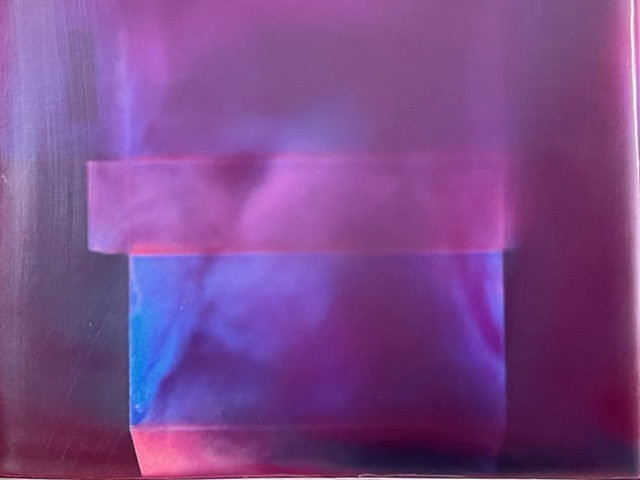Joanne Ungar is a singular talent. Her work is a luminous masterclass in the manipulation of color and wax. A gifted encaustic artist with a scientific approach to her art practice, she speaks directly through her chosen medium to address questions of beauty and pain.
We spoke about living in analog and digital worlds, women’s beauty and finding your own art world.
Photo and video documentation by Daniel Paterna
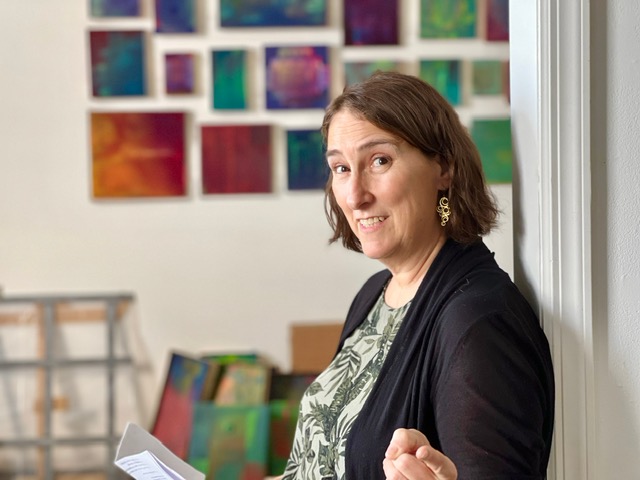 MICHELE JASLOW: Let’s talk women’s place in beauty and art. In your work you incorporate Botox packaging. Is Botox a connection between beauty and art?
MICHELE JASLOW: Let’s talk women’s place in beauty and art. In your work you incorporate Botox packaging. Is Botox a connection between beauty and art?
JOANNE UNGAR: When I first started working with Botox boxes it wasn’t coming from the “beauty” angle, it was coming from the “pain” angle, because Botox is also used to treat migraines. They inject it into your head and for some people it actually cures migraines. Go figure. At that time, I was working on a series that I called the Pain Relief Series, and all the boxes that I used were from what I loosely determined to be pain relief products.
That is where the Botox came in. At the same time, prior to the Pain Relief Series, the beginning of all this work started with boxes from what I call the “beauty industry”. My part-time day job is tangentially in the beauty industry: I am a digital retoucher of faces, hair, cosmetics, and packaging for commercials and sometimes movies. I don’t feel good about this work that I do, culturally and ethically. For me it’s fun work and I’m really good at it, and it’s what allows to me to keep my art practice funded. But in my studio, I wanted to subvert it, turn it on its head, and do my own kind of push back. I don’t pretend to be an effective social activist with it. I just wanted to work with the concept of packaging and the way advertising agencies package women and package what they consider to be the feminine look and, getting back to Botox and surgical enhancements, the way women are socially encouraged to homogenize themselves.
This homogenization of women freaks me out. I find it remarkable that on the one hand our society is trying to embrace diversity on many levels, while on the other hand people are using filters and fillers in order to all achieve the same look!
This homogenization of women freaks me out.
I don’t judge women who opt in to surgically enhance their look, because as an older woman I get it. But overall, it is a cultural situation that I find problematic.
Working with packaging was initially a double entendre. As in, what exactly gets packaged? Who gets represented by the advertising agency? And, you know, the whole idea of fitting in and what/who fits into the package and what society thinks is acceptable.
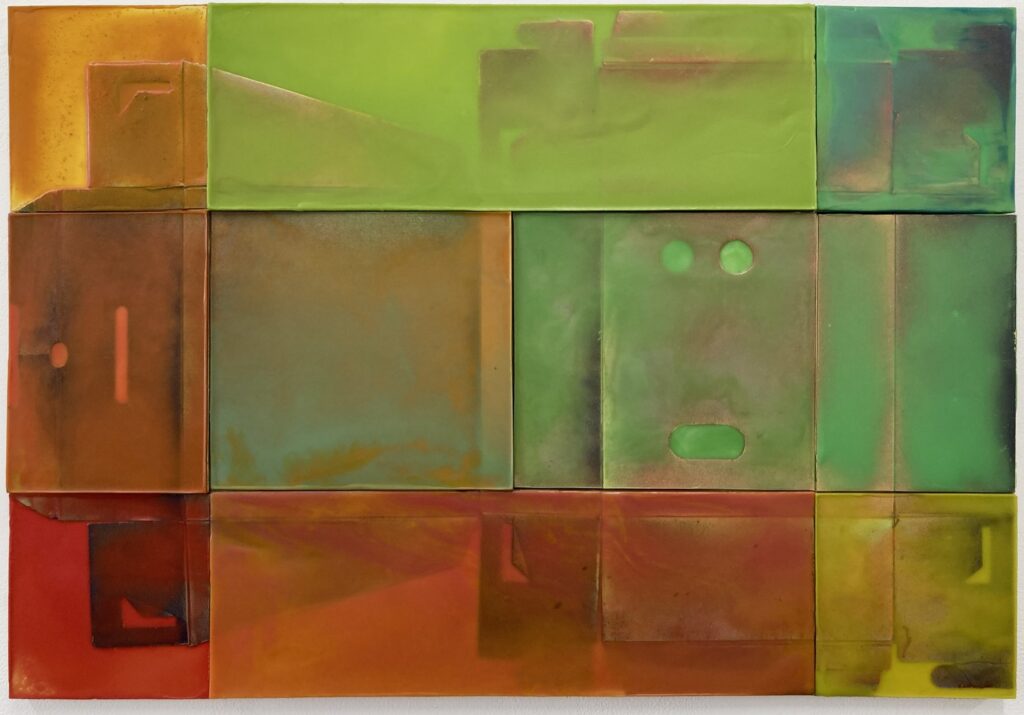
See Ungar’s work at her Front Room Gallery solo exhibition, opening October 21, 2023 at 205 Warren Street, Hudson, NY
JOANNE: My color choices are completely intuitive. A lot of it is technical for me. Working with encaustic is tricky. It’s molten when I’m working with it, and when it’s molten, you can’t accurately see what color it is. I’ll know I have a blue or green and hopefully I’ve paid attention to the details of the colors that I’m mixing, but it’s not possible to be very sure of exactly how it will cure.
To me that’s enormously exciting as an artist. To not know exactly what the end result will be. I know some artists are all about control, but I’m not. The lack of control keeps me engaged. I’m always trying to make a perfect piece and of course I can never make a perfect piece and installation.
The lack of control keeps me engaged.
MICHELE: So how do you know when you are done if it’s never perfect?
JOANNE: A lot of these pieces I make over and over and over. I make a piece and I hang it on the wall. Sometimes it’s up there for a year or two and then I decide it’s not good enough. And I take it down, I melt it down and I rework it. There’s a piece in the other room that I’ve just made for the third time, and I think it’s not done but I’m not sure yet. I’ll probably rework it, ruin it, melt it down again and try again. That’s just my process.
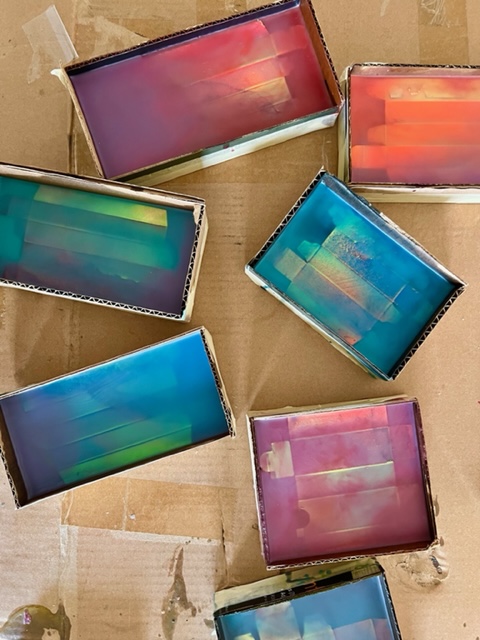 Sometimes when I try to improve a piece I ruin it. It happens. To answer your question, what usually happens is that with time, after it’s been on the wall for a while, like for weeks or months, it becomes clear to me whether or not it’s finished.
Sometimes when I try to improve a piece I ruin it. It happens. To answer your question, what usually happens is that with time, after it’s been on the wall for a while, like for weeks or months, it becomes clear to me whether or not it’s finished.
Before I started this series working with boxes I was using cosmetics and their packaging and I made these little assemblages, kind of like tiny Cornell boxes with mascara and eye shadow. Sometimes I incorporated some of the dead waterbugs that littered that studio.
At the time I didn’t think that it was good enough work to expand upon. Plus, it was tiny because cosmetics are tiny. But I did show my favorite one in a little feminist group show here in NYC. In that one I used a pack of eye shadow with four different shades and with a plastic flip up top and a brush on the side. I took out the little dishes of eye shadow and replaced them with four different grades of sandpaper, ranging from smooth to gritty. I loved it and all it implied!
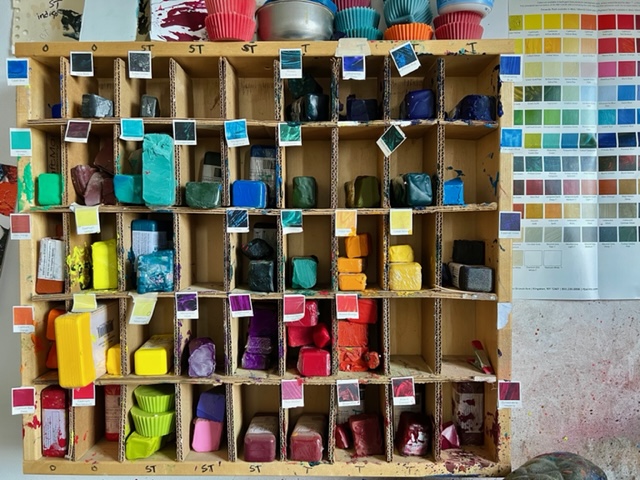 MICHELE: Do you think that’s good for you specifically and artists in general to let go of old work?
MICHELE: Do you think that’s good for you specifically and artists in general to let go of old work?
JOANNE: I don’t. I would love to still have those old cosmetics pieces, because I think they were a progenitor for the following body of work. I would like to be able to show them when people ask me how and why I work with cosmetics boxes
.
MICHELE: Because your work is in part about marketing how do you take what you’ve learned and apply it to marketing your own work?
JOANNE: I don’t have a lot to say about this. I am not a wise marketer – it’s something I really struggle with, and I’m endlessly grateful to the Front Room Gallery for doing as much marketing for me as they do! During my first solo show in Brooklyn in 2003, before I was affiliated with the Front Room Gallery, I had a visit from a successful video artist I knew. She was endlessly frustrated with me due to my lack of worldly communication skills and promotional skills. But she came to see my show and she told me two things that have really stuck with me. The first thing that she imparted was that it doesn’t matter how good your work is. A lot of people make good work, and it’s not really relevant in terms of getting seen and selling and growing in the market. In other words, you have to do more than just make good work! The other thing she told me, and this was just at the beginning of the internet, was that there are a lot of art worlds now. She said it used to be that there was just one art-world. It was the world of Artforum and blue chip galleries. But now there’s many, many art worlds, and you need to find your own art world. Unspoken was that you need to become engaged with this chosen art world and participate in its dialog and contribute to its vibrancy.
VIDEO: An inside look: Joanne Ungar shares with us a detail within her process.
You need to find your own art world.
And I think that speaks to what you were saying before: that you just need a good Instagram account and it’s a matter of finding your art world. Personally, I like the gallery and the art world I’m in. But I completely agree that my way is not the only way to be an artist.
MICHELE: Let’s talk about validation.
JOANNE: I have a part-time day-job as a video artist in the tv/film world. I’d rather not have to have a day job, obviously, but I do mostly enjoy this one. One reason I find it gratifying is because somebody will say “good job” or “nicely done” at the end of a job or a task, which is very validating! When you are alone in your studio you never hear that. You don’t get any feedback at all. When you’re an artist working in your studio you’re working in a vacuum, which has it’s upsides, but validation is not on the menu. These days I have collectors who collect my work and that has been extremely validating. And I believe in that validation – I know they are buying my work because it speaks to them, and that is priceless to me. I need that validation as an artist.
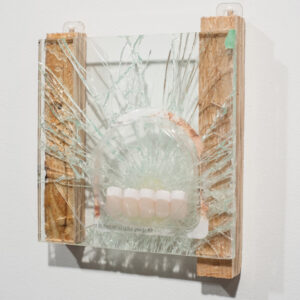
“I was using cosmetics and their packaging and I made these little assemblages, kind of like tiny Cornell boxes.”
JOANNE: I have a lot of issues with social media, but I do participate. Overall, phone and computer screens in general are not a good presentation platform for my work. When you see my work online or on your phone it looks very graphic and flat. And of course, the colors are never accurate. At best, it looks like a pretty, graphic image. When you view my work that way you’re seeing the just tip of the iceberg, and it’s nowhere close to a full experience of the work. Plus, there is no obvious directive to pursue it further. I do my best to use social media to promote my shows and my studio practice. But I don’t think anyone has ever decided to buy an Ungar from seeing it online. Purchases happen when they see the work IRL.
If Instagram is going to be the platform for viewing my work maybe I should just make my work in photoshop. I have the skillset to do it.
MICHELE: Why don’t you? Here you are someone that has the advanced skillset to do it but chooses not to.
JOANNE: It’s important for me to physically make the work. I love making physical three-dimensional art! I may be contradicting myself when I say this, but I would still be making this work if no one was buying it. I’m not a businessperson selling a product!
Joanne Ungar is represented by Front Room Gallery.
Follow https://www.instagram.com/joanneungar
View https://joanneungar.com/home.html
Own https://www.frontroomles.com/ungar-home

